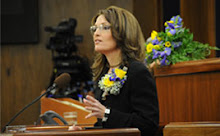Stand blocked federal control of Alaskans
Talking back to the daily news
By GOV. SARAH PALIN
Published: May 29th, 2009 11:30 PM
Last Modified: May 30th, 2009 02:30 AM
In response to your May 27 editorial, let me explain why I vetoed $28.6 million of federal stimulus funds tied to adoption of universal energy building codes.
 The feds required me to certify these codes "will be implemented" or pushed on local communities. My record is clear. I support conserving energy through weatherization and I'm an advocate for harnessing renewable sources of energy. But conditions here required more "big brother" government involvement than most Alaskans want and the new codes could cost Alaskans thousands of dollars per new home and renovation.
The feds required me to certify these codes "will be implemented" or pushed on local communities. My record is clear. I support conserving energy through weatherization and I'm an advocate for harnessing renewable sources of energy. But conditions here required more "big brother" government involvement than most Alaskans want and the new codes could cost Alaskans thousands of dollars per new home and renovation. Alaskans have a strong history of independence and opposition to Washington, D.C., meddling in local issues. Our constitution ensures "maximum local self-government." Our communities have had the option to adopt building codes for decades. Most have not done so.
I've served as a city councilman and city mayor/manager. I've participated firsthand in the mandated building code debate. Anyone serving in local office knows strong deference to local communities leads to the best policies. That policy holds true with building codes.
My community went through a battle over building codes when our booming city desired more growth opportunities to allow job creation. The last thing we needed was a bureaucrat from Washington, D.C., telling us what the best policy was to adopt.
Strings were definitely attached to federal energy dollars. The stimulus law in section 410(a) (2), along with the Department of Energy's (DOE) official guidance, required certifying one of two options before Alaska could receive the energy conservation funds.
One option said the state "will implement" the 2009 International Energy Conservation Code for new homes and renovations; adopt a "building energy code [that meets or exceeds Standard 90.1-2007] for commercial buildings throughout the State"; and adopt and pay for a plan of "active" enforcement.
I could not certify this. The Legislature did not pass a bill adopting a statewide energy building code. In addition, the federal residential building code does not allow exemptions, such as we use in Alaska. When Alaska Housing Finance Corporation funds are used, building and energy codes can be waived due to the "high cost of implementation" in different areas of Alaska. One size does not fit all in Alaska.
The second option for Alaska was to certify that all "applicable units of local government that have authority to adopt building codes, will implement" the necessary energy codes and enforce them.
I could not certify this either. Alaska communities have the right to determine for themselves whether to adopt building codes.
I asked the feds to clarify their position. The Department of Energy finally admitted section 410 and their previous statements were "inappropriate" for some states but still wanted an agreement to push model codes on all Alaskan communities. I said no.
Beware of Washington, D.C., trying to cajole local community leaders to eliminate the choices Alaskans have when building or renovating homes and businesses. These new codes are so detailed they would dictate the kinds of lights that can be installed in a home in Akutan, and how thick window panes must be in Chignik.
We have hundreds of millions of dollars already budgeted for conservation, weatherization and renewable energy development. My administration will remain vigilant for Alaskans and oppose mandates or pressure to conform from Washington, D.C., bureaucrats.
----------------------------------------------------------------------------------
Sarah Palin is governor of Alaska.
http://www.adn.com/opinion/compass/story/813086.html

































